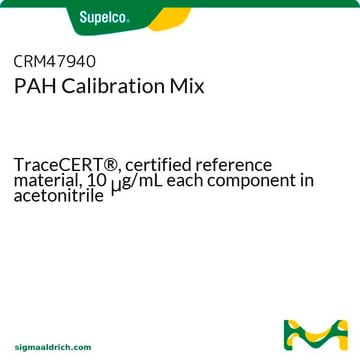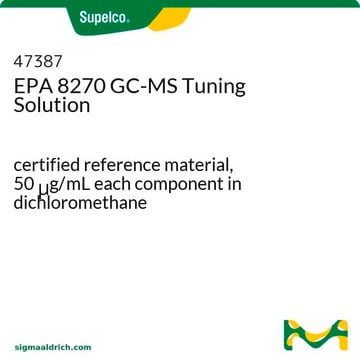50376-U
Ascentis® Express 90Å C8 (5 μm) HPLC Columns
L × I.D. 3 cm × 3 mm, HPLC Column
About This Item
Productos recomendados
product name
Ascentis® Express C8, 5 μm HPLC Column, 5 μm particle size, L × I.D. 3 cm × 3 mm
Materiales
stainless steel column
Nivel de calidad
Agency
suitable for USP L7
Línea del producto
Ascentis®
Características
endcapped
fabricante / nombre comercial
Ascentis®
envase
1 ea of
Parámetros
60 °C temp. range
600 bar max. pressure (9000 psi)
técnicas
HPLC: suitable
LC/MS: suitable
L × D.I.
3 cm × 3 mm
superficie
90 m2/g
impurezas
<5 ppm metals
matriz
Fused-Core particle platform
superficially porous particle
grupo activo de la matriz
C8 (octyl) phase
tamaño de partícula
5 μm
tamaño de poro
90 Å pore size
pH operativo
2-9
aplicaciones
food and beverages
técnica de separación
reversed phase
¿Está buscando productos similares? Visita Guía de comparación de productos
Descripción general
Información legal
Producto relacionado
obligatorio pero no suministrado
Código de clase de almacenamiento
11 - Combustible Solids
Clase de riesgo para el agua (WGK)
WGK 3
Punto de inflamabilidad (°F)
Not applicable
Punto de inflamabilidad (°C)
Not applicable
Elija entre una de las versiones más recientes:
Certificados de análisis (COA)
¿No ve la versión correcta?
Si necesita una versión concreta, puede buscar un certificado específico por el número de lote.
¿Ya tiene este producto?
Encuentre la documentación para los productos que ha comprado recientemente en la Biblioteca de documentos.
Artículos
When a C18 doesn′t give the desired separation, or your sample contains compounds that are known to be difficult to retain or resolve on a C18, consider changing to an Ascentis® Express C8 column.
Nuestro equipo de científicos tiene experiencia en todas las áreas de investigación: Ciencias de la vida, Ciencia de los materiales, Síntesis química, Cromatografía, Analítica y muchas otras.
Póngase en contacto con el Servicio técnico







